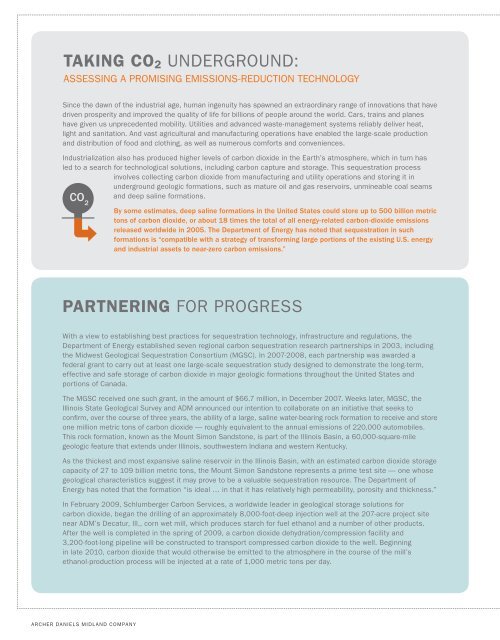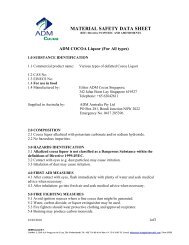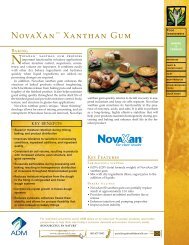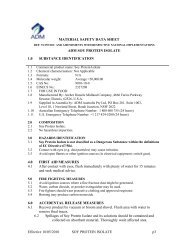Carbon Sequestration Brochure - ADM
Carbon Sequestration Brochure - ADM
Carbon Sequestration Brochure - ADM
You also want an ePaper? Increase the reach of your titles
YUMPU automatically turns print PDFs into web optimized ePapers that Google loves.
TAKING CO 2 UNDERGROUND:Assessing a promising emissions-reduction technologySince the dawn of the industrial age, human ingenuity has spawned an extraordinary range of innovations that havedriven prosperity and improved the quality of life for billions of people around the world. Cars, trains and planeshave given us unprecedented mobility. Utilities and advanced waste-management systems reliably deliver heat,light and sanitation. And vast agricultural and manufacturing operations have enabled the large-scale productionand distribution of food and clothing, as well as numerous comforts and conveniences.Industrialization also has produced higher levels of carbon dioxide in the Earth’s atmosphere, which in turn hasled to a search for technological solutions, including carbon capture and storage. This sequestration processinvolves collecting carbon dioxide from manufacturing and utility operations and storing it inunderground geologic formations, such as mature oil and gas reservoirs, unmineable coal seamsand deep saline formations.By some estimates, deep saline formations in the United States could store up to 500 billion metrictons of carbon dioxide, or about 18 times the total of all energy-related carbon-dioxide emissionsreleased worldwide in 2005. The Department of Energy has noted that sequestration in suchformations is “compatible with a strategy of transforming large portions of the existing U.S. energyand industrial assets to near-zero carbon emissions.”partnering for progressWith a view to establishing best practices for sequestration technology, infrastructure and regulations, theDepartment of Energy established seven regional carbon sequestration research partnerships in 2003, includingthe Midwest Geological <strong>Sequestration</strong> Consortium (MGSC). In 2007-2008, each partnership was awarded afederal grant to carry out at least one large-scale sequestration study designed to demonstrate the long-term,effective and safe storage of carbon dioxide in major geologic formations throughout the United States andportions of Canada.The MGSC received one such grant, in the amount of $66.7 million, in December 2007. Weeks later, MGSC, theIllinois State Geological Survey and <strong>ADM</strong> announced our intention to collaborate on an initiative that seeks toconfirm, over the course of three years, the ability of a large, saline water-bearing rock formation to receive and storeone million metric tons of carbon dioxide — roughly equivalent to the annual emissions of 220,000 automobiles.This rock formation, known as the Mount Simon Sandstone, is part of the Illinois Basin, a 60,000-square-milegeologic feature that extends under Illinois, southwestern Indiana and western Kentucky.As the thickest and most expansive saline reservoir in the Illinois Basin, with an estimated carbon dioxide storagecapacity of 27 to 109 billion metric tons, the Mount Simon Sandstone represents a prime test site — one whosegeological characteristics suggest it may prove to be a valuable sequestration resource. The Department ofEnergy has noted that the formation “is ideal … in that it has relatively high permeability, porosity and thickness.”In February 2009, Schlumberger <strong>Carbon</strong> Services, a worldwide leader in geological storage solutions forcarbon dioxide, began the drilling of an approximately 8,000-foot-deep injection well at the 207-acre project sitenear <strong>ADM</strong>’s Decatur, Ill., corn wet mill, which produces starch for fuel ethanol and a number of other products.After the well is completed in the spring of 2009, a carbon dioxide dehydration/compression facility and3,200-foot-long pipeline will be constructed to transport compressed carbon dioxide to the well. Beginningin late 2010, carbon dioxide that would otherwise be emitted to the atmosphere in the course of the mill’sethanol-production process will be injected at a rate of 1,000 metric tons per day.Archer Daniels Midland Company
















